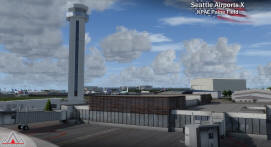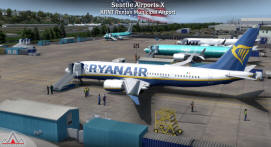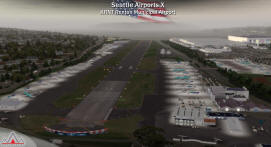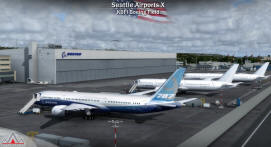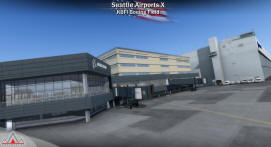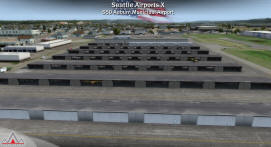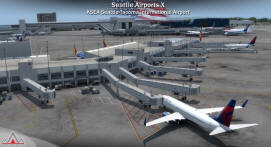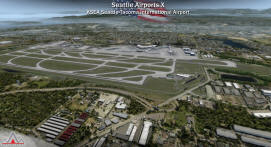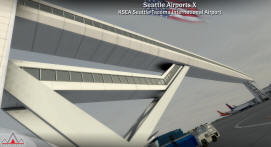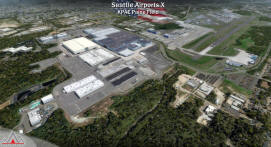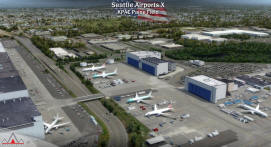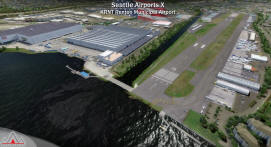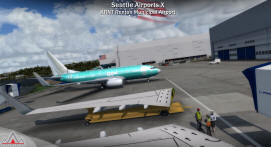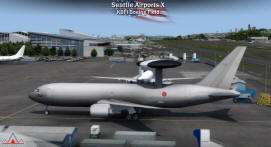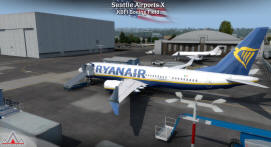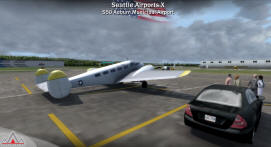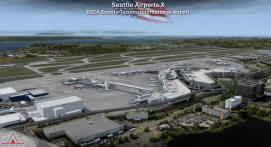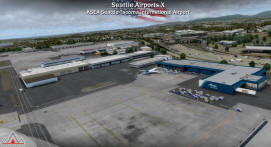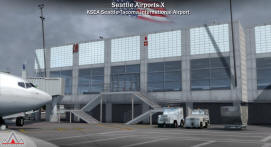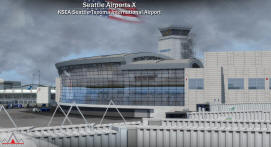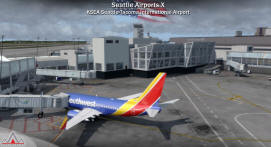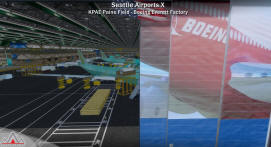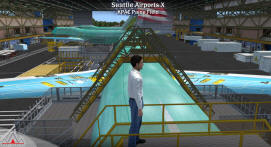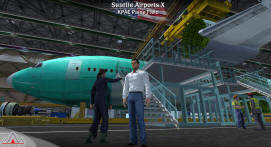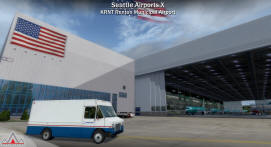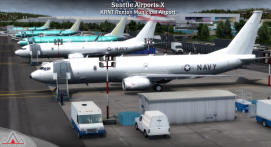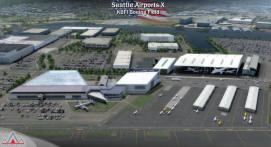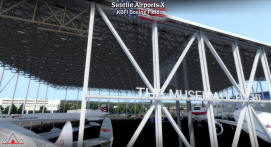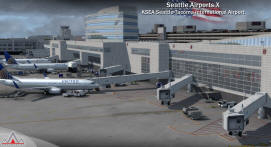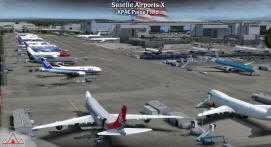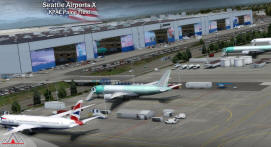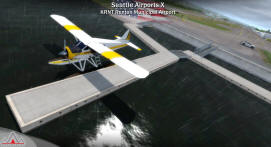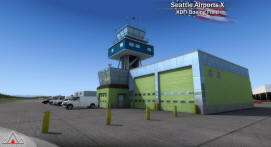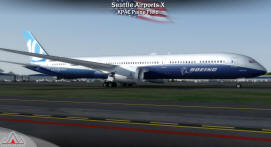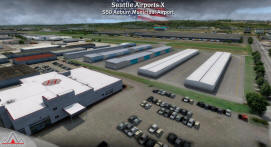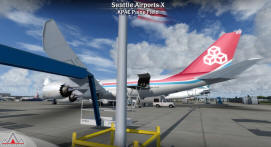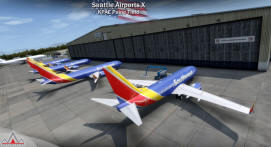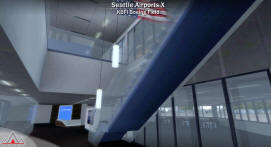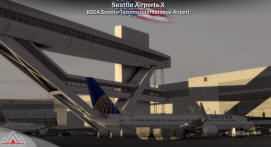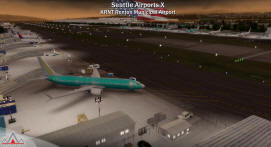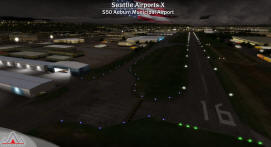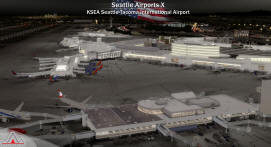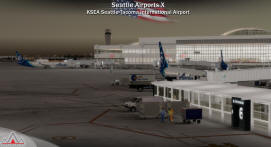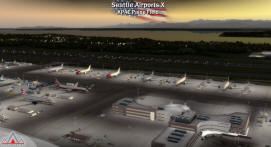|
Seattle Airports X
is the most complete, up-to-date, affordable, and
performance-friendly scenery package of 5 airports in the Seattle
metropolitan area, Washington State, USA. This product is compatible
with FSX-based platforms including Microsoft Flight Simulator X (FSX)
and Lockheed Martin Prepar3D (P3D). Please note that this product
does not include the city of Seattle but is fully compatible and
designed to work together with
Seattle City X by Drzewiecki Design.
A I R P O R T S
Seattle–Tacoma International Airport (IATA: SEA, ICAO: KSEA,
FAA LID: SEA), also referred to as Sea-Tac, is the primary
commercial airport serving the Seattle metropolitan area in the U.S.
state of Washington. It is located in the city of SeaTac,
approximately 13 miles (21 km) south of Downtown Seattle. The
airport, the largest in the Pacific Northwest region of North
America, is owned and operated by the Port of Seattle. The airport
has flights to cities throughout North America, Europe, the Middle
East, and Asia. It is the main hub for Alaska Airlines and its
regional subsidiary Horizon Air, whose headquarters are near the
airport. It is a hub and international gateway to Asia and Europe
for Delta Air Lines, which has expanded at Sea-Tac since 2011. The
airport is the 28th busiest airport in the world by passenger
traffic, serving over 45 million passengers in 2016, and is
considered one of the fastest-growing in the United States and the
world. It is categorized in the National Plan of Integrated Airport
Systems for 2015–2019 as a primary commercial service (large hub)
airport based on 16,121,123 enplanements in 2012. The airport is the
largest generator of vehicle trips in the state, and its 13,000-car
parking garage is North America's largest parking structure under
one roof. Busiest domestic destinations from Seattle–Tacoma are Los
Angeles, San Francisco, Anchorage, Denver, Las Vegas, Phoenix, and
Chicago. Busiest International destinations are Vancouver, Seoul,
London, Dubai, and Tokyo. ~40% of the traffic is served by Alaska
Airlines, ~15% by Delta Air Lines, ~11% by Horizon Air, ~8% by
Southwest Airlines, and ~7% by United Airlines.
Our product represents the airport after the expansion construction
work is completed - with the new International Arrivals Facility,
both Satellite Terminals modernized, additional structures added to
the A terminal, and with the amazing Skybridge. The project is
expected to be completed by 2021 at a cost of $766 million. After
the new IAF opens the South Satellite will continue to be used for
arriving international flights and additional international gates
will be added in Concourse A, nearly doubling the number of gates
capable of serving larger wide-body aircraft.
Paine Field (IATA: PAE, ICAO: KPAE, FAA LID: PAE), also known
as Snohomish County Airport, is a small international airport
serving part of the Seattle metropolitan area in the U.S. state of
Washington. It is located in unincorporated Snohomish County,
between the cities of Mukilteo and Everett, about 30 miles (48 km)
north of Seattle.
Paine Field is home to the Boeing Everett Factory an airplane
assembly building owned by Boeing. Located on the northeast corner
of Paine Field, it is the largest building in the world by volume at
13,385,378 m3 and covers 399,480 m2. This is the factory where the
wide-body Boeing 747, 767, 777, and 787 are assembled. Plans for the
factory were first announced in 1966 for it to be the site of the
construction of the 747 after Boeing was awarded a US$525 million
contract from Pan American World Airways to build 25 747s. It
purchased 780 acres north of the then little-used Paine Field, which
was operated by the US Army in World War II. Boeing has had an
Everett presence since 1943. In 1968 it began offering factory tours
with the first roll-out of the 747. Over 150,000 people visit the
Everett Site each year. The factory includes a Boeing Employees'
Credit Union branch and several cafés. Across the airport to the
west is The Boeing Store, a theater, and a Future of Flight Aviation
Center, which runs the factory tour. The Everett Factory employs
over 30,000 people, including its own fire department, security
team, daycare center, and fitness center.
Boeing Field, officially King County International Airport (IATA:
BFI, ICAO: KBFI, FAA LID: BFI), is a public airport owned and
operated by King County, five miles south of downtown Seattle,
Washington. The airport has some passenger service but is mostly
used by general aviation and cargo. It is named after the founder of
Boeing, William E. Boeing. The airport's property is mostly in
Seattle just south of Georgetown, with its southern tip extending
into Tukwila. It covers 594 acres (240 ha) and has more than 375,000
operations yearly. It is in the National Plan of Integrated Airport
Systems for 2011–2015, which called it a primary commercial service
airport.
The Boeing Company has facilities at the airport. Final preparations
for delivery of Boeing 737 aircraft after the first test flight are
made at Boeing Field. Boeing facilities at the airport have also
included a paint hangar and flight test facilities. The initial
assembly of the 737 was at Boeing Field in the 1960s because the
factory in Renton was at capacity building the Boeing 707 and Boeing
727. After 271 aircraft, production moved to Renton in late 1970.
Production of military airborne early warning and control aircraft
based on the 737 is located at Boeing Field.
Renton Municipal Airport (IATA: RNT, ICAO: KRNT, FAA LID: RNT)
is a public-use airport located in Renton, a city in King County,
Washington, United States. The airport's northern boundary is Lake
Washington and the Will Rogers - Wiley Post Memorial Seaplane Base.
Renton Airport has a floating dock and a launching ramp for
conversion from wheeled landings to water takeoffs and landings. The
airport is owned by the City of Renton and is a general aviation
airport that serves Renton and other nearby communities. It provides
regional aviation services for air charter, air taxi, corporate,
business, and recreational flyers.
Renton Airport is adjacent to the Boeing Renton Factory which is a
facility where Boeing 737 Next Generation and MAX airliners are
built. 1,119 B-29s and 943 C-97s were built in the Renton plant. In
May 1954 the prototype of what would become the Boeing 707, the
Boeing 367-80, was rolled out at the Renton plant starting a long
association with the production of the Boeing 707 line. When the
first production Boeing KC-135 Stratotanker first flew in August
1956 from Renton it was named City of Renton. The first production
Boeing 707 was rolled out at Renton on 28 October 1957 and
production continued to the last 707. The Boeing 707 final assembly
building was also used to produce the Boeing 727 three-engined
airliner from 1963 into the 1980s. The first four 747s built were
refurbished in the Boeing Renton Factory. The plant also built all
1,050 Boeing 757s. In order to produce the twin-engined Boeing 737,
a new assembly line was built at Renton and the plant is still
building the Boeing 737 family. The 737 final assembly building when
built was at the time the largest building in the world by volume.
New aircraft perform their first flight from the adjacent Renton
Municipal Airport and are then flown to Boeing Field for customer
preparation.
Auburn Municipal Airport (FAA LID: S50) is a city-owned
public-use airport located 2 nautical miles (3.7 km) north of
downtown Auburn, in King County, Washington. It is included in the
Federal Aviation Administration (FAA) National Plan of Integrated
Airport Systems for 2017–2021, in which it is categorized as a
regional reliever facility. The airport covers an area of 110 acres
(45 ha) and contains one asphalt paved runway. Mostly used for
general aviation, the airport offers no commercial service. With 318
aircraft based at Auburn, including 293 single-engine, 14
multi-engine aircraft, and 11 helicopters. The airport averages 450
operations per day.
|




 |






